#crimehistory
Text




Colorized Mugshots of Australia's Most Notorious Female Criminals of the 1920s
#colorizedphotography#australianhistory#femalecriminals#mugshots#truecrime#1920s#crimehistory#vintagephotography#criminalminds#womeninhistory#criminalwomen
53 notes
·
View notes
Text
In the annals of true crime, few stories are as chilling and haunting as that of Robert Hansen, infamously known as the Butcher Baker. Here we delve into the life, crimes, and the enduring legacy of one of America’s most notorious serial killers.
#RobertHansen#Abduction#Alaska#AmericanCrime#Anchorage#ButcherBaker#ChillingSaga#ColdCase#CrimeHistory#CriminalJustice#CriminalMinds#CriminalPsychology#DarkSecrets#Documentary#FBI#Hunting#Imprisonment#InfamousCriminals#Investigation#Justice#Kidnapping#Legacy#Macabre#ModusOperandi#Murder#NaturalCauses#SerialKiller#TrueCrime#frnwh
3 notes
·
View notes
Text
Keep Him Safe: The Awful Exchange of Leonarda Cianciulli
From early on Leonarda’s life was filled with tragedy and deep pools of darkness, but by the time she was forty-five years old it may have appeared like the bad years were behind her. According to all outward appearances she had four children that she adored, her family was freshly settled into a new home, she opened a small shop that proved to be successful, and she found friends in her neighbors. It seemed like there was very little to dislike about Leonarda. After all, she was friendly, generous, wise, and she was known to lend a helping hand to people chasing their dreams that reached far outside their town of Correggio. And then there were her baking. Her treats were enjoyed by many, but only because no one knew the truth about them.
Leonarda Cianciulli was born in Montella in the Kingdom of Italy on April 18th 1894. In her early life she attempted suicide twice before marrying a registry office clerk named Raffaele Pansardi in 1917. Cianciulli’s mother immediately disapproved of the union and there were already plans for Leonarda to marry someone else, but she refused. According to Leonarda’s memoir, the marriage to Pansardi caused her mother to put a curse on the pair before they moved to his hometown of Lacedonia. Some might say the curse was successful, between 1917 and 1939 Cianciulli became pregnant seventeen times and of the seventeen three were lost and ten of the children died at a very young age. In 1927 Cianciulli spent just over a year in prison for fraud after creating a fake account with a sizeable amount of money in a ledger at the bank where she worked as an evening cleaner. On July 23rd 1930 the Irpinia earthquake struck and totally destroyed her home forcing the family to relocate to Correggio. Looking for answers to all the turmoil in her life Leonarda sought the insight of at least one fortune teller. The news was not good, not only was she told all of her children would die young, but a palm reader also told her that "In your right hand I see prison, in your left a criminal asylum."

A scene of devastation after the Irpinia Earthquake. Image via Wikimedia Commons.
After moving to Correggio Leonarda seemed to have entered a new chapter in her life. The people of Correggio welcomed her and her family and she and Raffaele became well-liked by the townspeople. After a lifetime of broken connections and instability Leonarda quickly found herself in an unfamiliar position: having friends. There were dinner parties, casual visits with neighbors, and Leonarda was well respected for her wisdom, insight, wit, and skills. The extreme paranoia and anxiety she had developed over the course of her life may have actually started to dissipate while she started new hobbies like writing poetry. She even re-opened the little shop attached to her new home and became successful at selling her homemade goods like soap. But, like so many other times in her life, turmoil was coming.
When World War II broke out nearly four million Italians joined the military to serve their country and among them was Giuseppe Pansardi, Leonarda’s eldest and favorite child. For an obsessively over protective mother, the thought of losing a child on the battlefield could have been suffocating, but for the psyche of Leonarda it was absolutely catastrophic. She remembered that the fortune teller said all her children would die young and she had already lost thirteen of them. No matter what she had to do, she was not going to lose her son to war. The solution was clear to her; she would offer human sacrifices in exchange for his protection.
The first was Faustina Setti, a woman who often confided in Leonarda that she desperately wanted to find a husband. The confession wasn’t overly unusual, the seventy-six year old Faustina was good friends with Leonarda and the two saw each other on a regular basis. On one particular visit with her friend Faustina was met by a very excited Leonarda who had some astounding news for her, she found her a husband, a man in the city of Pula that she had been exchanging letters with. She sent him a photograph of Faustina and he immediately said that not only did he want to meet her, he wanted her to be his wife. All of this should have seemed bizarre to Faustina but she was so overcome with joy at the news of a husband that no questions or hesitation came to mind. Leonarda was thrilled for her friend and offered to plan the entire trip to Pula for her. But she had one very specific rule that Faustina had to follow. She told her to be careful, that friends and family would try to discourage her from going. In order to avoid any problems Leonarda instructed her to write a series of letters to them in advance, assuring them she was safe in Pula and very happy. Leonarda promised to mail them for her. It was all for the best. It was a total lie.
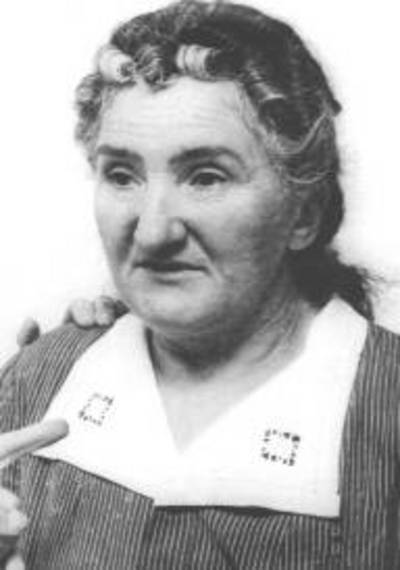
A later photograph of Leonarda. Image via https://horroresrevelados.wordpress.com/2017/03/20/leonarda-cianciulli-creaba-jabones-con-humanos/
On the morning of Faustina’s departure she went once again to Leonarda’s home. It was early, quiet, and Faustina was sitting at her friend’s table with shaking nerves and empty pockets. Leonarda had made her dreams come true, the least she could do was give her all of her life savings. As usual, Leonarda was there for her friend, she handed her a glass of wine to calm her nerves. It worked quickly. Faustina became calmer…and calmer…and her eyes and limbs got heavier…and heavier. We will never know if Faustina saw Leonarda approaching her with the ax. She thought she entered the home as a friend, she had no idea she was Leonarda’s first sacrifice.
Leonarda was accustomed to butchering animals and she used those skills to cut Faustina Setti’s body into nine pieces. Her body parts were put in a pot with over ten pounds of caustic soda. The chemical turned the remains into a thick dark sludge that Leonarda disposed of in a nearby septic tank. But then there was the blood, there was an entire basin of it. Leonarda waited until it coagulated before putting it in her oven to dry out. Once it was ready she ground it up. Then she got rid of it…along with some flour, sugar, chocolate, milk, eggs, and margarine. She kneaded the dried blood of Faustina into the dough and proceeded to make a batch of her famous tea cakes which she generously shared with her friends.
But was the sacrifice of Faustina enough to ensure the safety of her son?
By August of 1940 Francesca Soavi was in need of help. The former schoolteacher had quit her job to take care of her ill husband and when he died she was left with very little. Unable to find work she sought out Leonarda, after all she heard about how Leonarda had found Faustina a husband and made her dreams come true. Francesca met Leonarda and amazingly, she said that she was able to help. As luck would have it Leonarda knew of a school in the city of Piacenza, and they had a job opening. It was a very sought after position but Leonarda told her not to worry, she would make magic happen. Sure enough, a few weeks later Leonarda gave Francesca the happy news that she got the mystery dream job. All she had left to do was pack and write letters in advance to her friends and family telling them she was happy and safe. She would not even have to worry about mailing them, Leonarda’s son would take care of that for her.
On September 5th 1940 Francesca arrived at Leonarda’s home in the early morning just before she departed for Piacenza. She wanted to thank her once again for helping her find a job and getting her back on her feet. Leonarda handed her a celebratory glass of wine. Once again Leonarda’s guest started to feel weak and once again her host grabbed the ax. Francesca met the very same fate as Faustina with her broken down, liquified remains being tossed into the septic tank and her blood being baked into tea cakes. Leonarda’s second sacrifice was complete.
As Giuseppe’s departure date loomed closer Leonarda’s worry over if she had done enough to ensure his safety might have been unbearable. She needed to find another sacrifice but this time she did not have to look far. Virginia Cacioppo was a celebrity in Correggio. She was a former opera singer who once sang at the famed La Scala opera house in Milan and her friends and neighbors often heard her tales of lavish living so many years ago. Now after spending a number of years away from the spotlight she missed her former life and her close friend Leonarda was happy to help her. Before long Virginia had good news, Leonarda found her a job as a secretary for an impresario who organized the kind of artistic events that she was so familiar with and missed so dearly. She had to act quickly though, the job was in Florence and she had a lot to do before moving and re-igniting her life.
On the morning of September 30th 1940 Virginia was ready to go, but she could not leave without thanking her friend Leonarda for all of her amazing help. She brought along her belongings and, of course, the letters that Leonarda told her to write in advance that would be mailed later telling everyone about her wonderful new life in Florence. Leonarda offered her a glass of red wine.
Once Virginia was dead on the floor Leonarda started the process again. The body was cut into pieces…the blood was put in a basin to dry for tea cakes…but this time was slightly different. The previous two times Leonarda put the body parts and the caustic soda in the pots the experiment went totally wrong and her friends ended up in the septic tank. This time it worked, according to Leonarda when she recalled the visit later on:
“She ended up in the pot, like the other two...her flesh was fat and white, when it had melted I added a bottle of cologne, and after a long time on the boil I was able to make some most acceptable creamy soap. I gave bars to neighbors and acquaintances. The cakes, too, were better: that woman was really sweet.”

Image via https://horroresrevelados.wordpress.com/2017/03/20/leonarda-cianciulli-creaba-jabones-con-humanos/
Leonarda may have thought her third sacrifice was a success and further ensured the safety of her son, but with the killing of Virginia she made a very big mistake. Her two previous victims, Faustina and Francesca, had families that were located far from Correggio and did not have anyone close by to notice that something was amiss, especially when they were still receiving letters from them. This was not the case with Virginia, she had a sister-in-law in town named Albertina Fanti who did not believe for an instant that she had left to pursue a new job. It was more than a simple hunch that Virginia would not up and leave. It was the added fact that the last time she saw Virginia she was walking into Leonarda’s home and shortly after her disappearance her clothes started popping up for sale in Leonarda’s shop.
The accounts of how Leonarda was arrested vary with some saying Albertina had to go to the police in Reggio Emilia after the local police in Correggio dismissed her. Some say she was questioned more than once and it was only after a bank voucher belonging to Virginia was traced back to Leonarda that her home was searched. Others say the items that brought her down were the letters from the three women, all with a similar story and all mailed after they arrived at Leonarda’s home and “went away” to their bright new futures. Law enforcement might not have known what they were facing when they entered Leonarda’s home to question her, but they probably did not expect what happened. The five-foot-tall forty-six year old woman casually confessed to killing the three women, cutting them into pieces, turning their flesh into discarded sludge and admired soap, and baking their blood into tea cakes. Reports state that during one search of her property the septic tank was searched and inside was found small portions of bone showing evidence of the soap-making process and a denture of fourteen teeth matching the one worn by Faustina Setti.
Leonarda was arrested but she did not see the inside of a courtroom for six years while the war raged on and her son Giuseppe, her “miracle child” that she committed such horrors for, fought in the army. While in prison attempts were made to determine if she was actually a cold-blooded killer or if she was legitimately insane. One of the most renowned Italian psychiatrists, Director of the Criminal Asylum of Aversa, Filippo Saporito, undertook this task and asked Leonarda to write about her life. Several years later he was presented with a memoir that was almost 800 pages long and entitled Confessions of a Bitter Soul filled with everything from passages from the Gospels to the grisly details on how she turned the bodies of the three women into tea cakes and soap.

Mugshot of Leonarda Cianciulli. Image via Wikimedia Commons.
According to the Criminology Museum in Rome when the trial began not everyone was so sure Leonarda was the only person responsible for the crimes. These were no simple murders and doubt began to grow that she could have killed the women and done the dismembering of the corpses herself. With suspicion growing the eyes of the courtroom began to shift over to the only other person that they felt could have been involved, Giuseppe. When questioned about his role in the murders Giuseppe admitted to mailing the letters for his mother, but he said he did not know anything about them. With the accusations creeping closer toward her son Leonarda became aggressively adamant he was not involved in the killings, even telling the courtroom to bring her a fresh corpse from the morgue and she would show them all how she did it right then in there, “I cut here, here and here in less than 20 minutes everything was done, including cleaning. I might as well prove it now.”
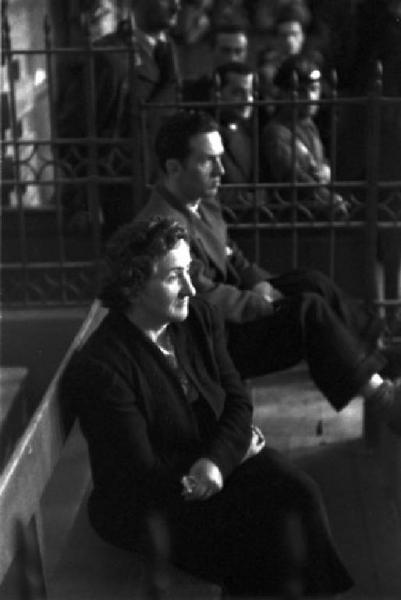
Leonarda Cianciulli during her trail. Image via https://murderpedia.org/female.C/c/cianciulli-leonarda-photos-2.htm
As the examination continued it became clear that Leonarda was their only killer with her even correcting the prosecutor on the finer details of her crimes. She was matter-of-fact, candid, and completely without remorse. At one point telling the courtroom “I gave the copper ladle, which I used to skim the fat off the kettles, to my country, which was so badly in need of metal during the last days of the war...."
The trial of Leonarda Cianciulli only took three days and the verdict was no surprise to anyone. She was convicted of the murders and was sentenced to thirty years in prison and three years in a criminal asylum. According to a nun who knew Leonarda during her imprisonment she was a quiet, calm, prisoner making the welcome speeches to visiting ministers and spending her time crocheting, writing, and baking sweets that the other prisoners refused to eat.
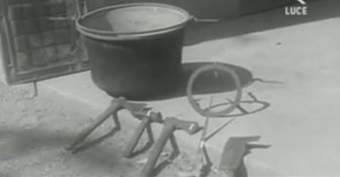
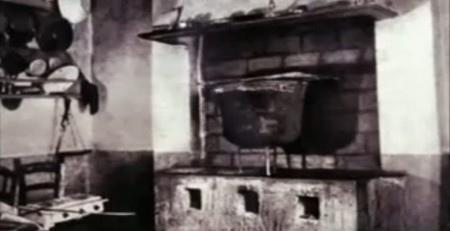
The tools allegedly used by Leonarda in her crimes.
Images via https://murderpedia.org/female.C/c/cianciulli-leonarda-photos-2.htm and https://www.letturefantastiche.com/la_saponificatrice_di_correggio.html
Leonarda Cianciulli died in the asylum on October 15, 1970 at the age of seventy-six. Her body was returned to her family and buried in a common grave of a local cemetery.
Over eighty years after the murders there are still many questions about Leonarda Cianciulli, “The Soap-Maker of Correggio.” What made her believe the answer to her son’s safety was human sacrifice? Did she really do what everyone says? There are some that say it would have been impossible for her to turn the remains of the women into tea cakes and soap inside her own home, but others say the evidence is clear. Some question her own accounts of the murders and wonder if she exaggerated everything to convince the court she was insane in order to avoid the death penalty. A maid allegedly spoke up decades later about seeing the body parts hidden in parts of the house. There will forever be some details that remain foggy but what is absolutely certain is that three women walked into the home of Leonarda Cianciulli excited by the promise of a new life, they never left, and the only traces of them ever found were in the septic tank, exactly where Leonarda said they met their end. Also found in the home were a cauldron, an ax, a hammer, a hacksaw, a kitchen cleaver, and trace amounts of blood in multiple rooms of the house.
The cauldron, axes, hacksaw, and knives used by Leonarda were obtained by the Criminology Museum in Rome and remained on display until the museum’s closure.
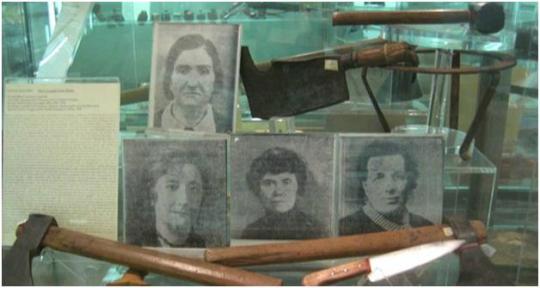
Portion of the exhibit on Leonarda in the Criminology Museum in Rome (now closed.) Image via https://allthatsinteresting.com/leonarda-cianciulli
***********************************************************
Sources:
“Foreign News: A Copper Ladle" Time Magazine published June 24th 1946.
“How Serial Killer Leonarda Cianciulli Made Her Victims Into Soap And Teacakes” by Katie Serena. Published January 29, 2018. allthatsinteresting.com/leonarda-cianciulli
“Leonarda Cianciulli: The Serial Killer Who Turned Her Victims into Soap” by Dan Hendrix vocal.media/criminal/leonarda-cianciulli-the-serial-killer-who-turned-her-victims-into-soap
“WWII Serial Killer Mom Sacrificed Victims to Keep Her Son Safe at War” by Karen Harris historydaily.org/wwii-serial-killer-mom-sacrificed-victims-to-keep-her-son-safe-at-war/4
“The Cianciulli case” www.focus.it/cultura/storia/545745165-il-caso-cianciuli-32653
“Murder: Cianciulli case” www.museocriminologico.it/index.php/2-non-categorizzato/120-omicidi-caso-cianciulli2
The Deadly Soap Maker of Correggio by Genovena Ortiz. True Crime Explicit Volume 6. Sea Vision Publishing 2022.
#HushedUHistory#featuredarticles#history#ItalianHistory#CrimeHistory#LegalHistory#TrueCrime#FamousTrueCrime#horrorhistory#horrorstory#forgottenhistory#strangehistory#tragichistory#truehorror#sadhistory#scarystory#weirdhistory#shockinghistory#shockingstory#truth is stranger than fiction#scary#tragictale#terrifying#historyclass
2 notes
·
View notes
Text
youtube
Mysterious Case Of Thomas Randolph: A Murderer Of Four Wives
#youtube#Investigative#TrueCrime#SerialKiller#ThomasRandolph#CrimeStory#MurderMystery#Investigation#UnsolvedMysteries#CrimeDocumentary#TrueCrimeCommunity#Murderer#CriminalMinds#Justice#ColdCase#CrimeSeries#CrimeHistory#CrimePodcast#CrimeEnthusiast#CriminalProfiler#thomas#Murder#Serialkiller#blackwidower#unsolvedmysteries#foryou
1 note
·
View note
Text
Griselda Blanco: The Notorious Cocaine Queen 👑💎 Delve into the riveting saga of Griselda Blanco, the infamous Colombian drug lord who rose to power in the male-dominated world of narcotics. From her early criminal exploits to her reign as the "Black Widow," explore the captivating tale of a woman who left an indelible mark on the history of organized crime. 🌐🚬
For more information:- https://www.allaroundworlds.com/notorious-cocaine-queen/
0 notes
Text
Virginia Hill and her street life | @danatruppiana
Explore the captivating life of Virginia Hill in this intriguing video. Join us as we delve into her street-smart journey. From her connections to notorious gangsters to her mysterious disappearance, Virginia's story is one of intrigue and danger.
#VirginiaHill#StreetLife#Gangsters#TrueCrime#MysteriousDisappearance#MobConnections#InfamousWomen#CrimeHistory#NotoriousFigures#VirginiaHillDocumentary
0 notes
Text
Unveiling the Dunbar Armored Robbery: Unraveling Inside Job or Perfect Heist?"
youtube
"Unveiling the Dunbar Armored Robbery: Unraveling Inside Job or Perfect Heist?" Prepare to be captivated as we delve into one of the most audacious #perfectheist in modern history: the enigmatic #dunbararmoredrobbery. In this gripping exposé, we will explore the tantalizing possibility that insiders in Dunbar armored heist were the puppet masters pulling the strings in this #cinematicrobbery.
#DunbarArmoredRobbery#PerfectHeist#InsideJob#AudaciousRobbery#CrimeHistory#HeistMystery#CinematicRobbery#TrueCrime#RobberyMystery#CrimeExposé#Youtube
0 notes
Text
The Banco Central Burglary: The World's Biggest Bank Heist - Economydiary

In the annals of criminal history, one heist stands out as the epitome of audacity and meticulous planning—the Banco Central Burglary. This incredible story revolves around the world's largest bank heist, where a group of cunning criminals pulled off an extraordinary theft that captivated the world's attention.
The Setting: Banco Central do Brasil The stage for this audacious crime was the Banco Central do Brasil in Fortaleza, Brazil. The bank was known for its fortress-like security, and its underground vaults held vast quantities of Brazilian currency, making it an irresistible target for determined thieves.
The Mastermind: Antonio Jussivan Alves dos Reis At the heart of the operation was a man named Antonio Jussivan Alves dos Reis, a seemingly ordinary civil servant. He worked for the Brazilian central bank and had inside knowledge of the bank's security systems, making him the ideal mastermind for the heist.
The Meticulous Plan: Dos Reis spent months meticulously planning the operation. He rented a commercial property nearby and posed as a landscaping business owner, all the while tunneling a massive underground passage towards the bank's vault. The tunnel was a staggering 78 meters long and reached a depth of 10 meters, allowing access to the bank's vault from below.
The Heist: On the weekend of August 6, 2005, dos Reis and his team of burglars executed their audacious plan. They tunneled into the vault and managed to avoid the bank's advanced security systems. Inside, they filled duffel bags with Brazilian currency. The thieves were able to make off with an astounding 160 million Brazilian reais (equivalent to approximately $70 million USD at the time).
The Escape: After the heist, dos Reis and his gang disappeared into the night, leaving behind a gaping hole in the vault's floor. They left the authorities baffled and unable to trace their whereabouts.
The Aftermath: The Banco Central Burglary sent shockwaves through Brazil and the international law enforcement community. It was considered one of the most sophisticated and daring heists in history.
The Capture: Despite their meticulous planning, the criminals' luck eventually ran out. In a case of poetic justice, dos Reis was arrested when authorities tracked his extravagant spending habits. The sheer volume of stolen cash made it difficult for him to remain discreet.
The Legacy: The Banco Central Burglary remains one of the most infamous bank heists globally. It highlights the lengths to which determined criminals can go and the importance of security measures in safeguarding financial institutions.
Conclusion: The Banco Central Burglary serves as a gripping reminder that fact can be stranger than fiction. The audacity and meticulous planning that went into this heist captured the world's imagination. While the criminals behind this colossal theft ultimately faced justice, their daring escapade will forever be etched in the annals of history as the world's biggest bank heist.
The allure of extraordinary heists continues to captivate us, reminding us that sometimes truth truly is stranger than fiction in the world of crime and intrigue.
#BancoCentralHeist#BankHeist#TrueCrime#BrazilianHeist#CrimeHistory#NotoriousRobbery#HeistStory#CriminalMastermind#UnsolvedMysteries#LargestBankRobbery
0 notes
Text
Part 3 - Albert Anastasia Escaped the Electric Chair to Die in a Barber Chair - Part 3

Albert Anastasia (born “Anastasio,” the masculine form of the Italian name) was a mobster who came out of the tough streets of Lower Manhattan to run one of the Five Families of La Cosa Nostra through the first half of the 20th century. Along the way, he built a reputation as one of the Mob’s most feared killers. Anastasia was reportedly a member of Murder Incorporated, the kill-for-hire crew that worked for Charlie “Lucky” Luciano and others in the years of Prohibition. Anastasia was, according to reports, one of the four men in 1931 who assassinated Giuseppe “Joe the Boss” Masseria, a powerful Mob boss, in the bloody gang rivalry known as the Castellammarese War. Anastasia was charged in three murders – in 1928, 1932 and 1933 – but in each case, witnesses either disappeared or refused to testify. Two other high-level Mob informants, both under police custody, died before their testimony helped bring Anastasia to trial, in 1941 and 1942. During World War II, Anastasia joined the U.S. Army. He also reportedly helped engineer the deal that eventually allowed Luciano, then ostensibly serving a life sentence for multiple prostitution-related convictions, to get out of prison (and go into exile in Italy) in exchange for keeping the New York City docks free of wartime Nazi infiltration. Anastasia worked for the Army training longshoremen on the East Coast. In 1943, he received U.S. citizenship for his military service, and he was honorably discharged from the Army in 1944. Eventually, Gambino moved against his sometime family boss. Anastasia was gunned down while he was sitting in a barber chair in Manhattan. Gambino assumed the family leadership, which would eventually become known as the Gambino crime family.
#AlbertAnastasia#MobsterLegacy#MurderIncorporated#CastellammareseWar#GangsterLife#CriminalUnderworld#WWIIService#GambinoCrimeFamily#MobBossAssassination#CrimeHistory
0 notes
Photo

The details are of the Red Barn Murder are fairly straightforward. A woman was killed and buried in a red barn by her lover. It’s the media coverage and the public obsession with it that made it history. In our modern life we’ve seen the trials of people like OJ Simpson, Scott Petersen, or Jodi Arias become huge media sensations. But in the 19th century this was still a new concept. The Red Barn murder and it’s resulting trial is the predecessor of the true crime media sensation we know today. Find out more in this week's newsletter! Link in bio to subscribe! × × × × × × × × × × × × #history #worldhistory #historybuff #historynerd #historynerds #historyfacts #historylover #historic #truecrime #crimehistory #britishhistory #redbarnmurder #murder #crime https://www.instagram.com/p/CkHbi0frly0/?igshid=NGJjMDIxMWI=
#history#worldhistory#historybuff#historynerd#historynerds#historyfacts#historylover#historic#truecrime#crimehistory#britishhistory#redbarnmurder#murder#crime
0 notes
Photo
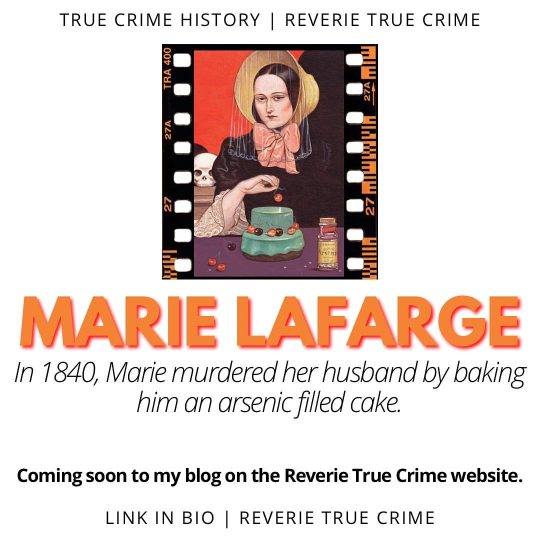
I’m in the process of writing short, true crime stories (pre-1920s) each week on my website since I normally don’t cover them on the show. The blog on my website is called, True Crime History. I’ll write short posts about old-timey crimes, laws, and punishments. ✨Coming soon! . . . #oldcrimes #pre1920 #truecrimehistory #historicalcrime #crimehistory #truecrimefacts #crimefacts #arsenic #poisoning #oldlaws #criminalpunishment #punishments #victorianera #victorianhistory #19thcenturyhistory #18thcenturyhistory #19thcentury #18thcentury #17thcentury #17thcenturyhistory #18thcenturylife #19thcenturylife #murderhistory #criminalhistory #crimehistory #crimestory #crimestories #truecrimecase #crimecase #crimecases #truecrimeblog https://www.instagram.com/p/ChkyRDWpsfU/?igshid=NGJjMDIxMWI=
#oldcrimes#pre1920#truecrimehistory#historicalcrime#crimehistory#truecrimefacts#crimefacts#arsenic#poisoning#oldlaws#criminalpunishment#punishments#victorianera#victorianhistory#19thcenturyhistory#18thcenturyhistory#19thcentury#18thcentury#17thcentury#17thcenturyhistory#18thcenturylife#19thcenturylife#murderhistory#criminalhistory#crimestory#crimestories#truecrimecase#crimecase#crimecases#truecrimeblog
1 note
·
View note
Text
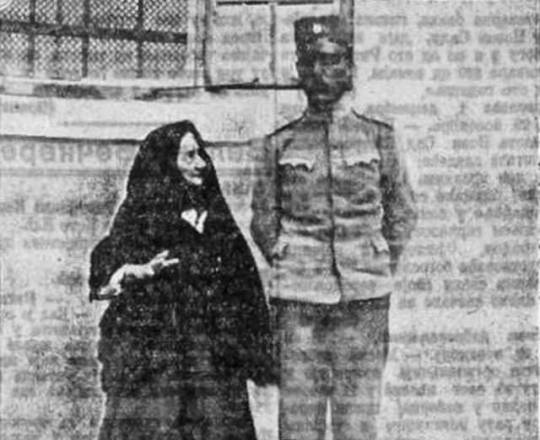



Baba Anujka The World's Oldest Serial Killer and Her Reign of Terror
#BabaAnujka#serialkiller#truecrime#criminalmind#historicalcrimes#crimehistory#unsolvedmystery#investigation#crimejournalism#murderouswomen#truecrimestory#criminology
0 notes
Text
In the annals of crime history, few stories are as chilling and perplexing as that of Jose Manuel Martinez, a man who claimed to be a ruthless cartel enforcer responsible for over 30 killings across the United States. His dark and violent exploits came to light in a series of confessions that shocked investigators and unveiled a decades-long reign of terror.
#CartelActivities#CartelEnforcer#CrimeHistory#CrimeInvestigation#CriminalLegacy#DarkUnderworld#InvestigativeChallenges#JoseMartinez#LegalProceedings#MurderConfessions#OrganizedCrime#PleaDeal#ReignOfTerror#ViolentExploits#frnwh
1 note
·
View note
Photo

We hope to see Thursday night where you can join the live discussion! Catch edited episodes by following Murder in the Moonlight on Anchor and Spotify. 🔗 link in bio🔗 In the 1970s, Dr. Charles Scudder and his partner Joe Odem created a "fortress" in northern Georgia to escape the world. The world, however, caught up with them in the form of their brutal murders. #murder #murderer #murderers #murders #killer #killers #true #truecrime #horrible #crime #murderinthemoonlight #dark #georgia #crimehistory #truecrimehistory #truecrimes #podcast #podcasts #podcastshow #creepy #scary #fyp #fypage #truecrimefan #truecrimefans #truecrimeallthetime #truecrimestory #truecrimestories #truecrimecommunity https://www.instagram.com/p/Cf-Pn_XML55/?igshid=NGJjMDIxMWI=
#murder#murderer#murderers#murders#killer#killers#true#truecrime#horrible#crime#murderinthemoonlight#dark#georgia#crimehistory#truecrimehistory#truecrimes#podcast#podcasts#podcastshow#creepy#scary#fyp#fypage#truecrimefan#truecrimefans#truecrimeallthetime#truecrimestory#truecrimestories#truecrimecommunity
0 notes
Photo

On This Day in New York City History March 1, 1912: NYPD Jail Matron Isabella Goodwin (February 20, 1865 - October 26, 1943) becomes the first female detective on the force.
She joined the police force in the late 1890's serving as a jail matron, a position that had her looking after female and children prisoners. In the course of her employment, Goodwin would go undercover from time to time to investigate crimes and gain access to locations such as women only gambling dens where male police officers could not enter. It was while undercover that her big break came.
In 1912, there was a robbery where $25,000 (roughly $770,000 in today's dollars) was stolen. One of the suspects was believed to frequent a boardinghouse for relations with one of its tenants. Goodwin went undercover as a scrubwoman at the boardinghouse. She did so until she gained enough evidence to have the suspect arrested and the case was solved.
For her actions, Goodwin was appointed as New York's first female detective and given the rank of 1st grade lieutenant. By the 1920's Detective Goodwin would oversee the Women’s Bureau that was tasked with investigating cases involving prostitutes, runaways, truants and victims of domestic violence. She would retire in 1924.
As of 2019, 6,570 women were working in New York City’s 36,500-member police force (18 percent) including 781 detectives, 753 sergeants and 200 lieutenants.
Goodwin would pass away on October 26, 1943 and is buried in Green-Wood Cemetary in Brooklyn.
#IsabellaGoodwin #WomensHistory #WomensStudies #HERStory #WomensHistoryMonth #NewYorkPoliceDepartment #NYPD #NYPDHistory #CrimeHistory #TrueCrime #NewYorkHistory #NYHistory #NYCHistory #History #Historia #Histoire #Geschichte #HistorySisco
(at One Police Plaza- NYC Police Headquarters)
https://www.instagram.com/p/CpPzBQUOsuZ/?igshid=NGJjMDIxMWI=
#Isabella Goodwin#Women's History#Women's Studies#HERstory#Women's History Month#New York Police Department#NYPD#NYPD History#Crime History#True Crime#New York History#NY History#NYC history#History#Historia#Histoire#Geschichte#HistorySisco
8 notes
·
View notes
Video
youtube
Unraveling the Secrets of Triads From Ancient Societies to Modern Crimin...
Discover the dark world of Triads, the Chinese-origin organized crime syndicates with a history dating back to the 18th century. Learn how they have transformed from secret societies to powerful global criminal networks, engaging in activities like drug trafficking and human smuggling. Despite relentless law enforcement efforts, the Triads' complex hierarchy and strict codes of conduct continue to make them a formidable force in the underworld. #Triads #ChineseMafia #OrganizedCrime #CriminalEmpires #Underworld #CrimeHistory #SecretSocieties #GlobalCriminalNetworks #DrugTrafficking #HumanSmuggling #Triads, #OrganizedCrime, #DrugTrafficking, #HumanSmuggling, #Underworld, #SecretSocieties, #GlobalCrimeNetworks, #LawEnforcement, #CriminalSyndicates
0 notes